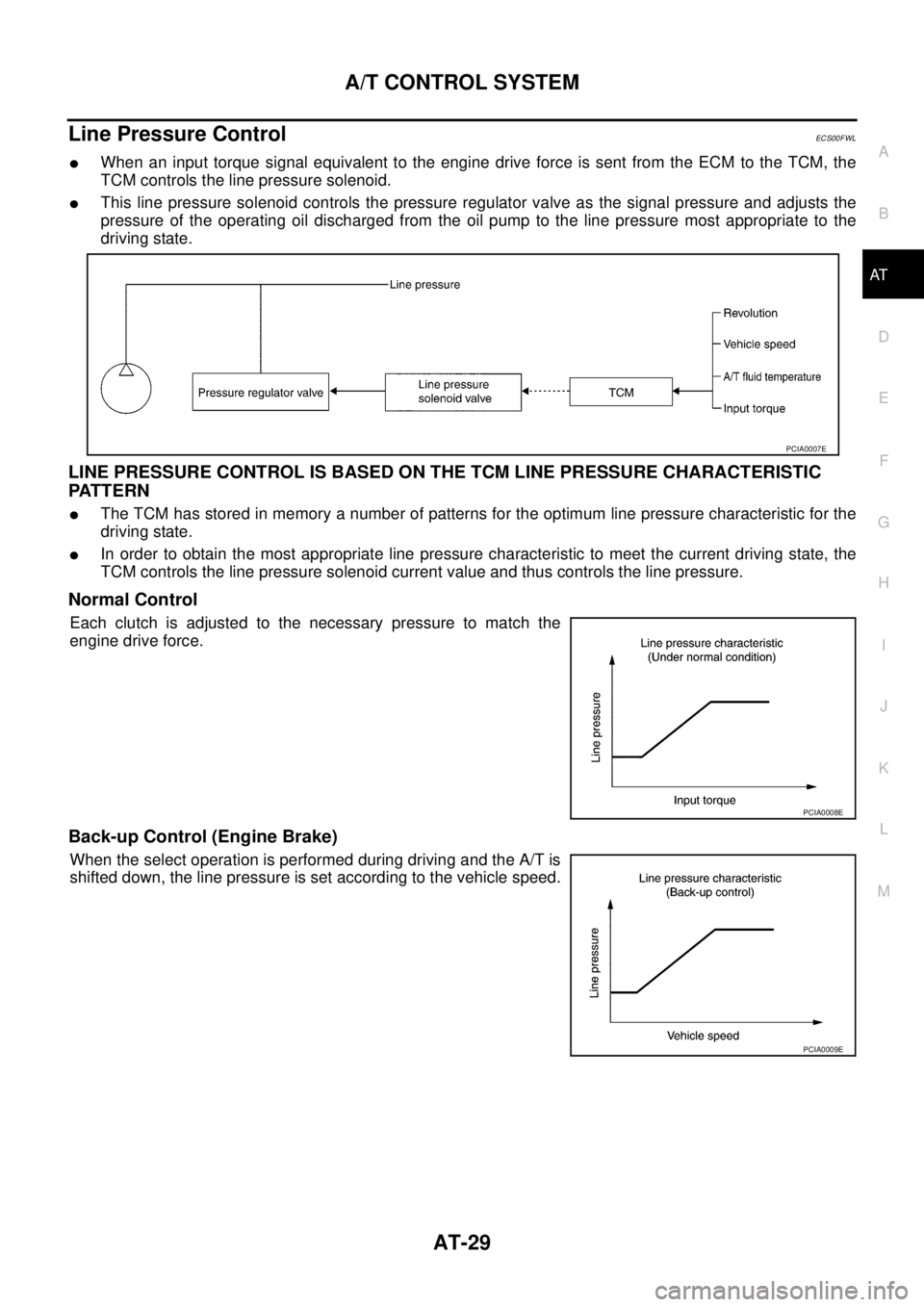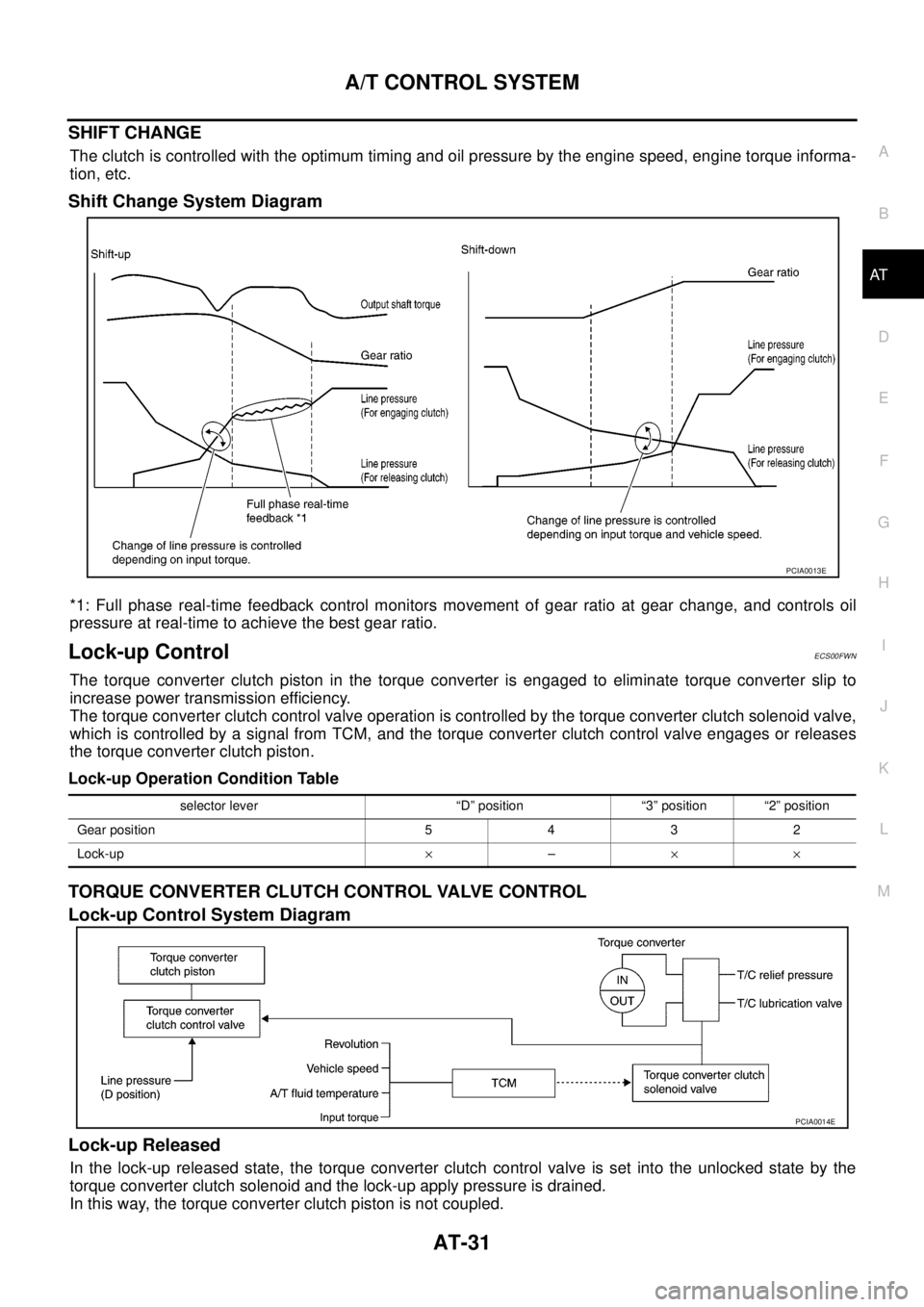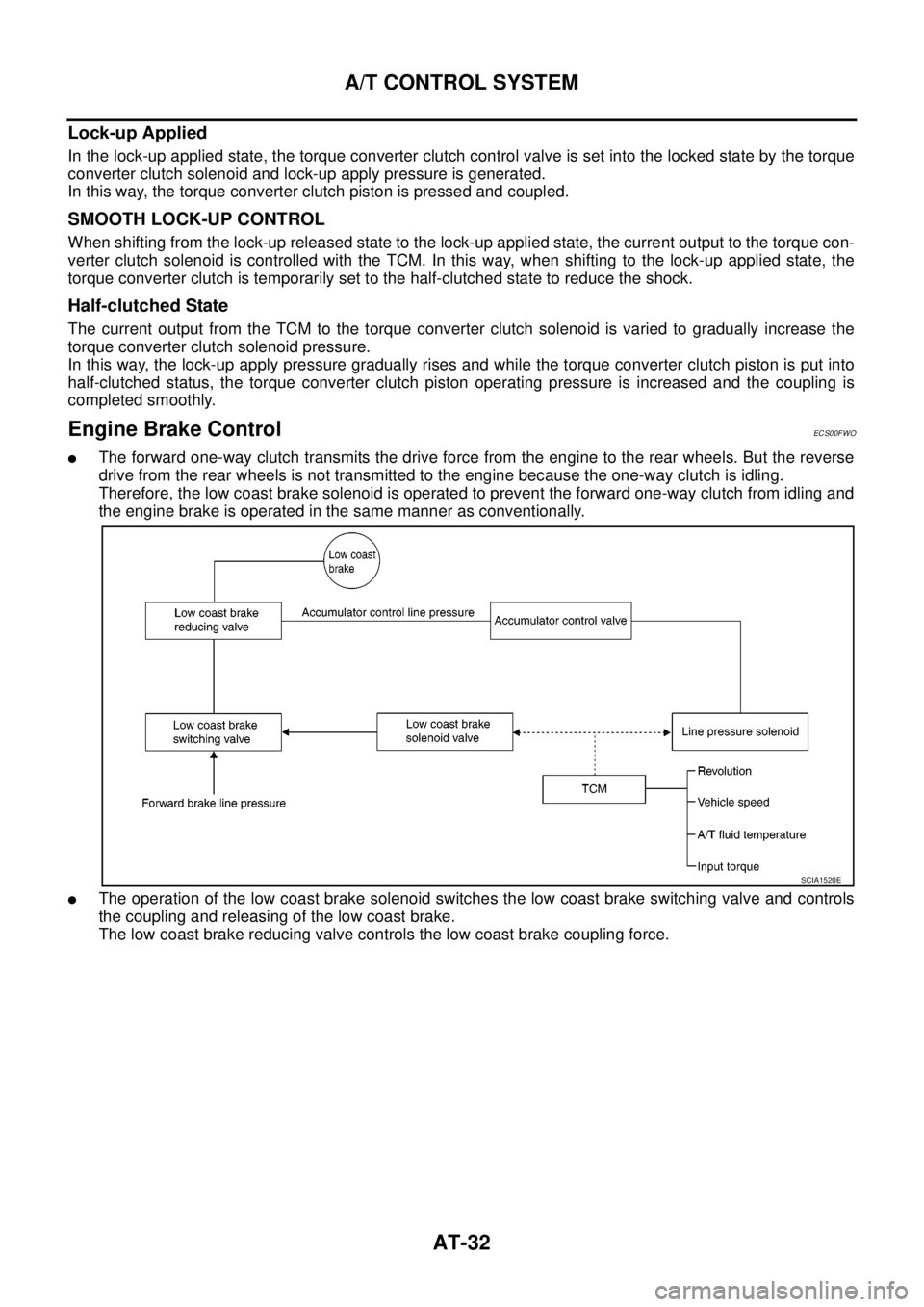2005 NISSAN NAVARA torque
[x] Cancel search: torquePage 37 of 3171

A/T CONTROL SYSTEM
AT-29
D
E
F
G
H
I
J
K
L
MA
B
AT
Line Pressure ControlECS00FWL
lWhen an input torque signal equivalent to the engine drive force is sent from the ECM to the TCM, the
TCM controls the line pressure solenoid.
lThis line pressure solenoid controls the pressure regulator valve as the signal pressure and adjusts the
pressure of the operating oil discharged from the oil pump to the line pressure most appropriate to the
driving state.
LINE PRESSURE CONTROL IS BASED ON THE TCM LINE PRESSURE CHARACTERISTIC
PAT T E R N
lThe TCM has stored in memory a number of patterns for the optimum line pressure characteristic for the
driving state.
lIn order to obtain the most appropriate line pressure characteristic to meet the current driving state, the
TCM controls the line pressure solenoid current value and thus controls the line pressure.
Normal Control
Each clutch is adjusted to the necessary pressure to match the
engine drive force.
Back-up Control (Engine Brake)
When the select operation is performed during driving and the A/T is
shifted down, the line pressure is set according to the vehicle speed.
PCIA0007E
PCIA0008E
PCIA0009E
Page 38 of 3171

AT-30
A/T CONTROL SYSTEM
During Shift Change
The necessary and adequate line pressure for shift change is set.
For this reason, line pressure pattern setting corresponds to input
torque and gearshift selection. Also, line pressure characteristic is
set according to engine speed, during engine brake operation.
At Low Fluid Temperature
When the A/T fluid temperature drops below the prescribed tempera-
ture, in order to speed up the action of each friction element, the line
pressure is set higher than the normal line pressure characteristic.
Shift ControlECS00FWM
The clutch pressure control solenoid is controlled by the signals from the switches and sensors. Thus, the
clutch pressure is adjusted to be appropriate to the engine load state and vehicle driving state. It becomes
possible to finely control the clutch hydraulic pressure with high precision and a smoother shift change charac-
teristic is attained.
PCIA0010E
PCIA0011E
PCIA0012E
Page 39 of 3171

A/T CONTROL SYSTEM
AT-31
D
E
F
G
H
I
J
K
L
MA
B
AT
SHIFT CHANGE
The clutch is controlled with the optimum timing and oil pressure by the engine speed, engine torque informa-
tion, etc.
Shift Change System Diagram
*1: Full phase real-time feedback control monitors movement of gear ratio at gear change, and controls oil
pressure at real-time to achieve the best gear ratio.
Lock-up ControlECS00FWN
The torque converter clutch piston in the torque converter is engaged to eliminate torque converter slip to
increase power transmission efficiency.
The torque converter clutch control valve operation is controlled by the torque converter clutch solenoid valve,
which is controlled by a signal from TCM, and the torque converter clutch control valve engages or releases
the torque converter clutch piston.
Lock-up Operation Condition Table
TORQUE CONVERTER CLUTCH CONTROL VALVE CONTROL
Lock-up Control System Diagram
Lock-up Released
In the lock-up released state, the torque converter clutch control valve is set into the unlocked state by the
torque converter clutch solenoid and the lock-up apply pressure is drained.
In this way, the torque converter clutch piston is not coupled.
PCIA0013E
selector lever “D” position “3” position “2” position
Gear position 5 4 3 2
Lock-up´–´´
PCIA0014E
Page 40 of 3171

AT-32
A/T CONTROL SYSTEM
Lock-up Applied
In the lock-up applied state, the torque converter clutch control valve is set into the locked state by the torque
converter clutch solenoid and lock-up apply pressure is generated.
In this way, the torque converter clutch piston is pressed and coupled.
SMOOTH LOCK-UP CONTROL
When shifting from the lock-up released state to the lock-up applied state, the current output to the torque con-
verter clutch solenoid is controlled with the TCM. In this way, when shifting to the lock-up applied state, the
torque converter clutch is temporarily set to the half-clutched state to reduce the shock.
Half-clutched State
The current output from the TCM to the torque converter clutch solenoid is varied to gradually increase the
torque converter clutch solenoid pressure.
In this way, the lock-up apply pressure gradually rises and while the torque converter clutch piston is put into
half-clutched status, the torque converter clutch piston operating pressure is increased and the coupling is
completed smoothly.
Engine Brake ControlECS00FWO
lThe forward one-way clutch transmits the drive force from the engine to the rear wheels. But the reverse
drive from the rear wheels is not transmitted to the engine because the one-way clutch is idling.
Therefore, the low coast brake solenoid is operated to prevent the forward one-way clutch from idling and
the engine brake is operated in the same manner as conventionally.
lThe operation of the low coast brake solenoid switches the low coast brake switching valve and controls
the coupling and releasing of the low coast brake.
The low coast brake reducing valve controls the low coast brake coupling force.
SCIA1520E
Page 41 of 3171

A/T CONTROL SYSTEM
AT-33
D
E
F
G
H
I
J
K
L
MA
B
AT
Control ValveECS00FWP
FUNCTION OF CONTROL VALVE
FUNCTION OF PRESSURE SWITCH
Name Function
Torque converter regulator valveIn order to prevent the pressure supplied to the torque converter from being excessive, the
line pressure is adjusted to the optimum pressure (torque converter operating pressure).
Pressure regulator valve
Pressure regulator plug
Pressure regulator sleeveAdjusts the oil discharged from the oil pump to the optimum pressure (line pressure) for
the driving state.
Front brake control valveWhen the front brake is coupled, adjusts the line pressure to the optimum pressure (front
brake pressure) and supplies it to the front brake. (In 1st, 2nd, 3rd, and 5th gears, adjusts
theclutchpressure.)
Accumulator control valveAdjusts the pressure (accumulator control pressure) acting on the accumulator piston and
low coast reducing valve to the pressure appropriate to the driving state.
Pilot valve AAdjusts the line pressure and produces the constant pressure (pilot pressure) required for
line pressure control, shift change control, and lock-up control.
Pilot valve BAdjusts the line pressure and produces the constant pressure (pilot pressure) required for
shift change control.
Low coast brake switching valve During engine braking, supplies the line pressure to the low coast brake reducing valve.
Low coast brake reducing valveWhen the low coast brake is coupled, adjusts the line pressure to the optimum pressure
(low coast brake pressure) and supplies it to the low coast brake.
N-R accumulator Produces the stabilizing pressure for when N-R is selected.
Direct clutch piston switching valve Operates in 4th gear and switches the direct clutch coupling capacity.
High and low reverse clutch control valveWhen the high and low reverse clutch is coupled, adjusts the line pressure to the optimum
pressure (high and low reverse clutch pressure) and supplies it to the high and low reverse
clutch. (In 1st, 3rd, 4th and 5th gears, adjusts the clutch pressure.)
Input clutch control valveWhen the input clutch is coupled, adjusts the line pressure to the optimum pressure (input
clutch pressure) and supplies it to the input clutch. (In 4th and 5th gears, adjusts the clutch
pressure.)
Direct clutch control valveWhen the direct clutch is coupled, adjusts the line pressure to the optimum pressure
(direct clutch pressure) and supplies it to the direct clutch. (In 2nd, 3rd, and 4th gears,
adjusts the clutch pressure.)
TCC control valve
TCC control plug
TCC control sleeveSwitches the lock-up to operating or released. Also, by performing the lock-up operation
transiently, lock-up smoothly.
Torque converter lubrication valveOperates during lock-up to switch the torque converter, cooling, and lubrication system oil
path.
Cool bypass valve Allows excess oil to bypass cooler circuit without being fed into it.
Line pressure relief valve Discharges excess oil from line pressure circuit.
N-D accumulator Produces the stabilizing pressure for when N-D is selected.
Manual valveSends line pressure to each circuit according to the select position. The circuits to which
the line pressure is not sent drain.
Name Function
ATFpressureswitch1(FR/B)Detects any malfunction in the front brake hydraulic pressure. When it detects any malfunction,
it puts the system into fail-safe mode.
ATFpressureswitch2(LC/B)Detects any malfunction in the low coast brake hydraulic pressure. When it detects any mal-
function, it puts the system into fail-safe mode.
ATFpressureswitch3(I/C)Detects any malfunction in the input clutch hydraulic pressure. When it detects any malfunction,
it puts the system into fail-safe mode.
ATF pressure switch 5 (D/C)Detects any malfunction in the direct clutch hydraulic pressure. When it detects any malfunc-
tion, it puts the system into fail-safe mode.
ATF pressure switch 6 (HLR/C)Detects any malfunction in the high and low reverse clutch hydraulic pressure. When it detects
any malfunction, it puts the system into fail-safe mode.
Page 43 of 3171

TROUBLE DIAGNOSIS
AT-35
D
E
F
G
H
I
J
K
L
MA
B
AT
A/T Interlock
lIf there is an A/T interlock judgment malfunction, the A/T is fixed in 2nd gear to make driving possible.
NOTE:
When the vehicle is driven fixed in 2nd gear, a turbine revolution sensor malfunction is displayed,
but this is not a turbine revolution sensor malfunction.
lWhen the coupling pattern below is detected, the fail-safe action corresponding to the pattern is per-
formed.
A/T INTERLOCK COUPLING PATTERN TABLE
l:NG X:OK
A/T 1st Engine Braking
When there is an A/T first gear engine brake judgment malfunction, the low coast brake solenoid is switched
OFF to avoid the engine brake operation.
Line Pressure Solenoid
The solenoid is switched OFF and the line pressure is set to the maximum hydraulic pressure to make driving
possible.
Torque Converter Clutch Solenoid
The solenoid is switched OFF to release the lock-up.
Low Coast Brake Solenoid
When a malfunction (electrical or functional) occurs, in order to make driving possible. If the solenoid is ON,
the A/T is held in 2nd gear. If the solenoid is OFF, the A/T is held in 4th gear. (Engine brake is not applied in
1st and 2nd gear.)
Input Clutch Solenoid
If a malfunction (electrical or functional) occurs with the solenoid either ON or OFF, the A/T is held in 4th gear
to make driving possible.
Direct Clutch Solenoid
If a malfunction (electrical or functional) occurs with the solenoid either ON or OFF, the A/T is held in 4th gear
to make driving possible.
Front Brake Solenoid
If a malfunction (electrical or functional) occurs with the solenoid ON, in order to make driving possible, the A/
T is held in 5th gear. If the solenoid is OFF, the A/T 4th gear.
High and Low Reverse Clutch Solenoid
If a malfunction (electrical or functional) occurs with the solenoid either ON or OFF, the A/T is held in 4th gear
to make driving possible.
Turbine Revolution Sensor 1 or 2
The control is the same as if there were no turbine revolution sensors, 5th gear is prohibited.
Gear positionATF pressure switch output
Fail-safe
functionClutch pressure output pattern after fail-safe func-
tion
SW3
(I/C)SW6
(HLR/C)SW5
(D/C)SW1
(FR/B)SW2
(LC/B)I/C HLR/C D/C FR/B LC/B L/U
A/T interlock
coupling pat-
tern3rd – X X –lHeld in
2nd gearOFF OFF ON OFF OFF OFF
4th – X X –lHeld in
2nd gearOFF OFF ON OFF OFF OFF
5th X X – XlHeld in
2nd gearOFF OFF ON OFF OFF OFF
Page 46 of 3171

AT-38
TROUBLE DIAGNOSIS
DIAGNOSTIC WORKSHEET
Information from Customer
KEY POINTS
lWHAT..... Vehicle & A/T model
lWHEN..... Date, Frequencies
lWHERE..... Road conditions
lHOW..... Operating conditions, Symptoms
Diagnostic Worksheet Chart
Customer name MR/MS Model & Year VIN
Trans. Model Engine Mileage
Malfunction Date Manuf. Date In Service Date
FrequencyoContinuousoIntermittent (times a day)
SymptomsoVehicle does not move. (oAny positionoParticular position)
oNo up-shift (o1st®2ndo2nd®3rdo3rd®4tho4th®5th)
oNo down-shift (o5th®4tho4th®3rdo3rd®2ndo2nd®1st)
oLock-up malfunction
oShift point too high or too low.
oShift shock or slip (oN®DoLock-upoAny drive position)
oNoise or vibration
oNo kick down
oNo pattern select
oOthers
()
OD OFF indicator lampoContinuously litoNot lit
1oRead the item on cautions concerning fail-safe and understand the customer's complaint.AT- 3 4
2oA/T fluid inspectionAT- 4 3oLeak (Repair leak location.)
oState
oAmount
3oStall test and line pressure testAT- 4 3
AT- 4 4oStall te st
oTorque converter one-way clutch
oFront brake
oHigh and low reverse clutch
oLow coast brake
oForward brake
oReverse brake
oForward one-way clutcho1st one-way clutch
o3rd one-way clutch
oEngine
oLine pressure low
oExcept for input clutch and direct
clutch, clutches and brakes OK
oLine pressure inspection - Suspected part:
Page 47 of 3171

TROUBLE DIAGNOSIS
AT-39
D
E
F
G
H
I
J
K
L
MA
B
AT
4oPerform all road tests and enter checks in required inspection items.AT- 4 6
4-1.Check Before Engine Is StartedAT- 4 6
oAT- 1 7 7 , "OD OFF Indicator Lamp Does Not Come On"
oPerform self-diagnosis. Enter checks for detected items.AT- 8 0,AT- 8 9
oAT-91, "DTC U1000 CAN COMMUNICATION LINE"
oAT-94, "DTC P0615 START SIGNAL CIRCUIT"
oAT-98, "DTC P0700 TCM"
oAT-99, "DTC P0705 PARK/NEUTRAL POSITION SWITCH"
oAT-103, "DTC P0720 VEHICLE SPEED SENSOR A/T (REVOLUTION SENSOR)"
oAT-108, "DTC P0725 ENGINE SPEED SIGNAL"
oAT-110, "DTC P0740 TORQUE CONVERTER CLUTCH SOLENOID VALVE"
oAT-112, "DTC P0744 A/T TCC S/V FUNCTION (LOCK-UP)"
oAT-114, "DTC P0745 LINE PRESSURE SOLENOID VALVE"
oAT-116, "DTC P1705 THROTTLE POSITION SENSOR"
oAT-118, "DTC P1710 A/T FLUID TEMPERATURE SENSOR CIRCUIT"
oAT-123, "DTC P1716 TURBINE REVOLUTION SENSOR"
oAT-125, "DTC P1721 VEHICLE SPEED SENSOR MTR"
oAT-127, "DTC P1730 A/T INTERLOCK"
oAT-130, "DTC P1731 A/T 1ST ENGINE BRAKING"
oAT-132, "DTC P1752 INPUT CLUTCH SOLENOID VALVE"
oAT-134, "DTC P1754 INPUT CLUTCH SOLENOID VALVE FUNCTION"
oAT-137, "DTC P1757 FRONT BRAKE SOLENOID VALVE"
oAT-139, "DTC P1759 FRONT BRAKE SOLENOID VALVE FUNCTION"
oAT-142, "DTC P1762 DIRECT CLUTCH SOLENOID VALVE"
oAT-144, "DTC P1764 DIRECT CLUTCH SOLENOID VALVE FUNCTION"
oAT-147, "DTC P1767 HIGH AND LOW REVERSE CLUTCH SOLENOID VALVE"
oAT-149, "DTC P1769 HIGH AND LOW REVERSE CLUTCH SOLENOID VALVE
FUNCTION"
oAT-152, "DTC P1772 LOW COAST BRAKE SOLENOID VALVE"
oAT-154, "DTC P1774 LOW COAST BRAKE SOLENOID VALVE FUNCTION"
oAT-156, "DTC P1841 ATF PRESSURE SWITCH 1"
oAT-158, "DTC P1843 ATF PRESSURE SWITCH 3"
oAT-160, "DTC P1845 ATF PRESSURE SWITCH 5"
oAT-162, "DTC P1846 ATF PRESSURE SWITCH 6"
4-2.Check at IdleAT- 4 7
oAT- 1 7 7 , "Engine Cannot Be Started in“P”or“N”Position"
oAT- 1 7 8 , "In“P”Position, Vehicle Moves When Pushed"
oAT- 1 7 9 , "In“N”Position, Vehicle Moves"
oAT- 1 8 0 , "Large Shock (“N”to“D”Position)"
oAT- 1 8 2 , "Vehicle Does Not Creep Backward in“R”Position"
oAT- 1 8 4 , "Vehicle Does Not Creep Forward in“D”Position"
4-3.Cruise TestAT- 4 8
Part 1
oAT- 1 8 6 , "
Vehicle Cannot Be Started from D1"
oAT- 1 8 8 , "A/T Does Not Shift: D1®D2"
oAT- 1 9 0 , "A/T Does Not Shift: D2®D3"
oAT- 1 9 2 , "A/T Does Not Shift: D3®D4"
oAT- 1 9 4 , "A/T Does Not Shift: D4®D5"
oAT- 1 9 6 , "A/T Does Not Perform Lock-up"
oAT- 1 9 7 , "A/T Does Not Hold Lock-up Condition"
oAT- 1 9 9 , "Lock-up Is Not Released"
oAT- 1 9 9 , "Engine Speed Does Not Return to Idle"